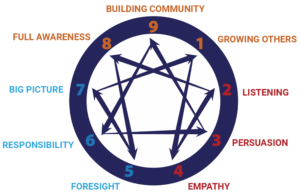Now more than ever, servant leadership is needed in government, corporations, small businesses, non-profits, and public service agencies. Coined by Robert Greenleaf in the 1970s, servant leadership refers to leaders being a “servant first… It begins with the natural feeling that one wants to serve, to serve first… a philosophy and set of practices that enriches the lives of individuals, builds better organizations and ultimately creates a more just and caring world.”
Not surprisingly, the Enneagram maps beautifully into some of the key principles of servant leadership, with each Enneagram type – taken as an archetype and not a personality type or specific ego structure – representing each of the most significant domains of servant leadership.
Servant leadership by Enneagram type:
Growing Others (1)
Commitment to the growth of others. Stewards believe that people have an intrinsic value beyond their tangible contributions as workers and, thus, are deeply committed to the growth and improvement of every individual and team.
Listening (2)
A deep commitment and ability to listen intently to others and to also sense the “will” of the group.
Persuasion (3)
The ability to persuade rather than continuously using positional authority to make things happen builds respect, influence and consensus; the continuous use of positional authority erodes respect for the leader. Stewards use positional authority sparingly and only when absolutely required.
Empathy (4)
The ability to understand and empathize with other people, but also accepting and acknowledging them as individuals even if you do not agree with or accept their behavior or performance.
Foresight (5)
Foresight enables stewards to understand the lessons from the past, the realities of the present, and the likely consequence of a decision and actions for the future. This requires both intuition and the ability to trust oneself.
Responsibility (6)
Stewards assume a commitment to serving the needs of others, including those who their organization or unit serves. The attitude is not one of “owning” the organization; it is one of having the honor of “holding the organization in trust” for others.
Big picture (7)
Stewards perceive the whole as well as the parts; they see the forest, trees, branches, leaves and roots. They also know what and when to leverage action and when some things take care of themselves.
Full awareness (8)
Self-awareness, awareness of others, and awareness of what is occurring in the environment are essential attributes for leaders who act as stewards. They see reality as it is, not a distorted version.
Building community (9)
Stewards stand at the helm of their organization or team, guiding it in times of certainty and uncertainty. This guidance is always with a keen sense of having a positive impact on the various communities in which it sits.
Ginger Lapid-Bogda PhD, the author of six best-selling Enneagram-business books, is a speaker, consultant, trainer, and coach. She provides certification programs for professionals around the world who want to bring the Enneagram into organizations with high-impact business applications, and is past-president of the International Enneagram Association. Visit her website: TheEnneagramInBusiness.com. ginger@theenneagraminbusiness.com


Comments are closed.